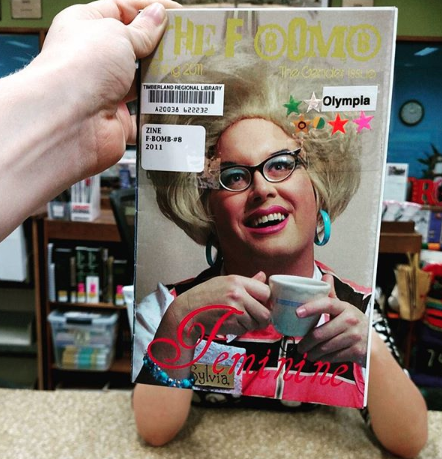Zines Are Popping Up in Public Libraries Across the U.S.
They’ve been around for decades, but is the underground art form now going mainstream?
By Jessie Schiewe
The next time you visit your local library, check to see if they have a zines section. (Art: Zita Walker)
For more than 80 years, zines have been around — but they’ve always been elusive.
The self-published, small circulation periodicals got their start in the science fiction community in the 1930s when fans — inspired by what they were reading — started writing, and later disseminating, their own stories. Punk scenes in cities like Los Angeles, New York, and London embraced zines in the ’70s and ’80s, and around that time, they became easier to make thanks to increasing access to photocopy machines and printers. Feminists and riot grrrls adopted the art form in the ’90s, using the often stapled, sewn, or folded-together pamphlets to publish poems, personal essays, articles, and literature that would be difficult to get published through traditional channels.
If this is your first time learning about zines, you’re not alone. Because they’ve existed predominantly within niche subcultures, they’ve always been the sort of commodity that requires “knowing someone” or being part of a particular scene to get ahold of one.
A pile of zines at the Olympia Timberland Library. (@olympiazinelibrary)
“You had to be in-the-know to know about them,” Stephen Duncombe, a professor of media and culture at New York University, told OK Whatever. “You had to know the cool record store. You had to know the person at the punk show who was handing them out.”
That’s no longer the case, and zines are easier to acquire than ever before. You can find them in both boutique and mainstream stores, at annual zine festivals, on college campuses, and in road-tripping Astro Vans. There’s even a day of the year dedicated to them. (It’s July 21st.)
Public libraries are also getting in on the zine-love and a large number are adding them to their collections. There are now around two dozen public libraries with zine sections nationwide in both rural and urban areas, including New York City, San Diego, San Francisco, Las Vegas, Denver, Austin, Los Angeles, Portland, Minneapolis, Baltimore, St. Louis, Jacksonville, and Cleveland.
“Zines in public libraries are a growing trend,” Agatha Burstein, a librarian at Olympia Timberland Library in Washington, said. “There’s a resurgence of interest in them. It’s helping foster a whole new community of zine makers and readers that might not have been there before.”
Jenna Freedman, an Associate Director of Communications at Barnard College who is also the school’s zine librarian, has also noticed an uptick in the amount of public libraries that are adding zines to their shelves. Compared to previous years, Freedman said she was “dazzled by the number of librarians” who have attended the last few annual Zine Librarians (Un)Conferences, which was first started in Seattle in 2009.
The Los Angeles Public Library has been particularly gung-ho in adding zine sections to their branches. You can now find them in six libraries across the city, including in Baldwin Hills, Echo Park, Koreatown, and Boyle Heights. Outside of Boston, the main branch of Somerville Public Library has been stocking its shelves with zines and other “small press” works for the more than a year.
“I think there’s a growing recognition at libraries that zines are a legit cultural form, created by people who have things to share,” Tim Devin, a librarian at Somerville Public Library, remarked. “And I think there’s a relatively new view that by not collecting zines, you’re being biased against a type of book.”
Zines are an easy sell to public libraries because they are cheap and not difficult to acquire. They’re also great excuses to throw events and reach out to readers. Burstein hosts a monthly zine club at the Olympia Timberland Library and runs an Instagram page for its zine section. They also spread interest by visiting college classes and teaching students how to make them. Those who complete the project can donate their zines to Burstein who displays them in the library.
The zine section at the Olympia Timberland Library has been steadily expanding over the years. (@olympiazinelibrary)
There’s also the belief that adding zine collections to public libraries will help draw in a new demographic of readers: people in their 20s and 30s. In fact, that’s why Ziba Perez Zehdar started the zine collection at Long Beach Public Library in the fall of 2015.
“I wanted to attract people my age that were not with children, had maybe just started or finished college, and were not teenagers,” Zehdar, who is currently spearheading the zine collections for the Los Angeles Public Library system, said. “I was trying to appeal to the age that I didn’t see coming in.”
The thinking goes that by adding more au currant literature to a library’s offerings, those who don’t normally visit libraries might be lured in. And that seems to be what’s happening. According to a 2016 Pew study, millennials are now the generation most likely to use a public library — thanks largely to librarians’ efforts to liven up their content.
Because if there’s one thing you should know about zines, it’s that they tend to be spicy and have more eclectic subject matter than a lot of books. At Burstein’s branch in Washington, you can check out zines on a broad range of topics, like queer history, “radical herbalism,” coming out, and how to brew your own kombucha.
As an underground art form with few barriers to entry, zines tend to be more daring, more raw, and more niche than published books. Marginalized or underrepresented people who might not be able to land book deals can still make zines and use them as tools for sharing their messages and viewpoints. And for librarians, that’s something to foster.
“Part of what we want to do is provide access to all different points of view and perspectives,” Burstein said. “Sometimes, certain voices are missing because there are barriers to getting published. Zines are a low barrier way of getting your voice heard.”
And yes, compared to a hardcover book — with its glossy jacket, sewn-together spine, and crisp, thick pages — zines might seem scruffy and out-of-place in a library, but Zehdar said it all boils down to what people are used to.
“It’s similar to what libraries did when they started adding graphic novels, comics, and even CDs and DVDs to their collections,” she said. “Maybe libraries hundreds of years ago were just strictly books, but then they started adding newspapers and magazines. So there’s always something new being added that eventually becomes a regular format in a library.”
As for why zines are only now being added to public libraries, some of it has to do with their current trendiness.
From activism to zephyrs, you can find zines on pretty much any topic. (@olympiazinelibrary)
“Libraries tend to look around at each other and see what each other is doing,” Burstein explained. “And once enough libraries start doing something, they all start doing it.”
It also has a lot to do with the current political and social climate. Zines give a voice to those who are not often heard from or given publicity, and while some are just fun diversions to read, others can shine a light on harsh realities and truths that do not often get reported on in mainstream media. And “with all the fake news out there,” Zehdar has noticed that readers are more open to alternative publications than they were in the past.
There is just one con to placing zines in libraries. By making them easier to obtain, you’re also potentially making them less cool.
“In the past, you had to be part of the culture to which zines spoke to know about them,” said Duncombe, who published one of the first definitive books on zines in 1997. “The problem with that, though, was that it excluded a whole bunch of people. It was essentially an elitist subculture. So it was great if you happened to live in Portland, but it wasn’t so good if you lived in Jackson Hole, Wyoming. You would just never find out about these sorts of things.”
Now, by placing zines on library shelves, we’re making them easier to acquire, but also potentially diluting the subcultures from which they originated. Going mainstream is a catch-22.
“The good thing is [zines] will get out to more people,” Duncombe said. “The bad thing is it’s no longer a path into an alternative culture. Instead, it’s just a path into a public library.”
Then again, in this day and age, those two things might be one and the same.



















Workwear as regular clothing is now a thing.